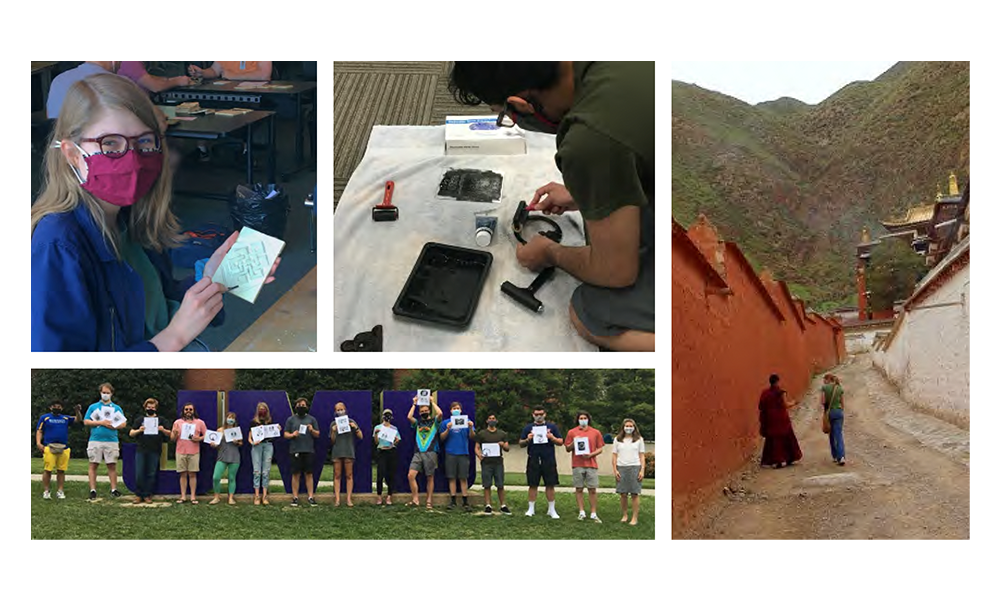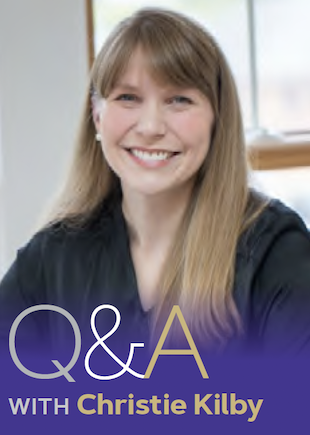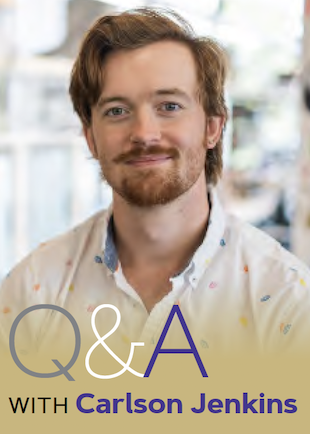Students learn ancient art of Buddhist printing
Featured Stories
SUMMARY: Religion professor Christie Kilby has passed down textual production knowledge from Tibetan communities to JMU. In her Introduction to Buddhism course, students use JMU Libraries' makerspace, The Makery, to create printing blocks similar to the ones Buddhists have made for more than a thousand years to print scriptures.
By Emily Blake
“I have studied block-printed texts for years as a scholar of Tibetan Buddhism … but I had never crafted my own printing blocks before,” said Christie Kilby, assistant professor of religion at JMU.
In Spring 2021, Kilby and her class visited The Makery, the makerspace in JMU Libraries, to embark on an unprecedented assignment. As part of her Introduction to Buddhism class, Kilby asked her students to create printing blocks similar to those that Buddhists have made for more than a thousand years in order to print scriptures. “The first printed book in world history was a Buddhist scripture (the Diamond Sutra) printed in China in 868 A.D.,” Kilby said.
|
“The students who chose the hand-cut linoleum block workshop spoke of how meditative and therapeutic the practice was.” — Christie Kilby, assistant professor of religion |
Kilby described how she developed the idea for the assignment: “My goal was for students to understand the art of textual production in Asia as well as the economics, resources, relationships and mindfulness that go into this work. So, on a whim, I attended a Makery workshop that Carlson Jenkins [educational technologist in JMU Libraries] offered on laser cutting. He was extremely supportive of my idea, encouraging me and engaging in an ongoing email conversation about how we could make my idea happen for my students. He met with me individually to test out some laser cuts and find images that would work well for my class. In the end, Carlson designed and led two different workshop series for my students—one on laser cutting and one on lino cutting. My students loved the process, and we all printed our own Buddhist texts and images in class using the blocks they made!”
Jenkins felt that offering the lino-cutting and laser-cutting options helped students engage more with the process. “I think the most successful part of this workshop was not just that the students were allowed to be creative, but that they also had a choice in how they could do that,” Jenkins said. “They could use their hands and physically carve a block print, or they can rely on software and a laser cutter to create the image. Some people find hand tools very intimidating, or they get frustrated because they can’t quite seem to capture their idea with a drawing. Similarly, some people find learning a new software, like Adobe Illustrator, a very frustrating process. I think that the act of choosing what technology to use imparts a sense of ownership over the project.”
While both the laser-cutting and lino-cutting options offered unique benefits, Kilby noted that hand carving the linoleum blocks gave students the opportunity to experience the meditative aspect of this ancient Buddhist practice. “The students who chose the hand-cut linoleum block workshop spoke of how meditative and therapeutic the practice was,” Kilby said. “In many religious practices, there is a lot of repetition that can become a form of meditation or prayer.”
Learn more about JMU Libraries’ makerspace at The Makery.
 Emily Blake: Can you tell me more about the Buddhist practice of creating printing blocks?
Emily Blake: Can you tell me more about the Buddhist practice of creating printing blocks?
Christie Kilby: Buddhism and printing have a long relationship with one another—printing has not only been a way for Buddhists to disseminate their sacred texts but has also functioned as a form of merit making, or virtuous activity, for Buddhists throughout the centuries.
Traditional xylography (the art of printing from wood blocks) involves cutting each page of text onto a wood block, backward and in relief. The inks and papers would have been handmade, and after printing a text, the blocks would be stored and used for future print runs. A tremendous amount of craftsmanship and skill goes into woodblock printing as well as hefty resources from patrons to finance book production. Traditional bookmaking brings the whole community together—patrons, artisans, scholars, scribes—quite a labor force. Our experience with Carlson at The Makery helped us see in a new way how making books the traditional way really does take a community.
(And as a side note, most people don’t know that metal moveable-type printing was developed in Korea a couple hundred years before Johannes Gutenberg.)
Blake: Was this your first time making printing blocks?
Kilby: Yes! I have studied block-printed texts for years as a scholar of Tibetan Buddhism, and I also received a fellowship with the Rare Book School at the University of Virginia, where I learned to analyze block-printed books as physical objects that carry their own histories of production, editing and distribution. But I had never crafted my own printing blocks before learning about the resources The Makery offers.
Blake: What did students share about how the project was personally meaningful for them?
Kilby: They enjoyed the chance to be creative and work with their hands. There are some lessons that you can only learn by doing—being humbled by the difficulty of a task or experiencing the foreignness of a type of knowledge transmission that is new to you.
Blake: Has this experience given you any ideas for future class projects?
Kilby: In the future, I would like to display our prints for the wider campus community in some way—a pop-up exhibit on the Quad, perhaps. I want more of the JMU community to see what we are doing in our religion courses!
 Blake: When you’re not laser cutting Buddhist printing blocks, what do you do at JMU Libraries?
Blake: When you’re not laser cutting Buddhist printing blocks, what do you do at JMU Libraries?
Carlson Jenkins: I am an educational technologist with JMU Libraries, meaning that I help students, faculty, staff and anyone else with all kinds of software and machines, from Canvas workshops for professors to sewing a shirt on a sewing machine. A lot of what I do is focused on bringing access to creative technology and related expertise to classrooms, but I also work very closely with The Makery, where a ton of tools, software and equipment are available to anyone on campus to come and use.
Blake: How do you hope that access to technologies through The Makery can make a difference at JMU?
Jenkins: The Makery is a place where students, faculty and staff can engage with creative technologies for any reason. Some people come in to work on a personal 3D-printing project right next to people working on their School of Media Arts and Design projects that are due that week. The Makery is a place where students can be self-guided in their learning; they can be very hands-on with the technology and create connections that they would not have otherwise been able to make. As a person who spends most of my time on creative projects, I really value a place like The Makery where anyone can come and be creative. You can come here with any level of experience and receive the help and access to technology you need to do whatever project you’re interested in.
Blake: What did you learn as part of this process?
Jenkins: This workshop was the first big workshop we coordinated during the pandemic. The Makery was not open to the public at this time, and everything was offered virtually or in one-on-one appointments. We were able to work in a series of small groups rather than having everyone come in one big group. That approach worked well for this project since there were so many different approaches to the assignment, and it allowed each group/individual to get more focused instruction.
Blake: What else would you like faculty and students to know?
Jenkins: There are so many different technologies and services available at The Makery and the Libraries in general. If you would like to visit The Makery to work on a project, you can check out the website for more information.

